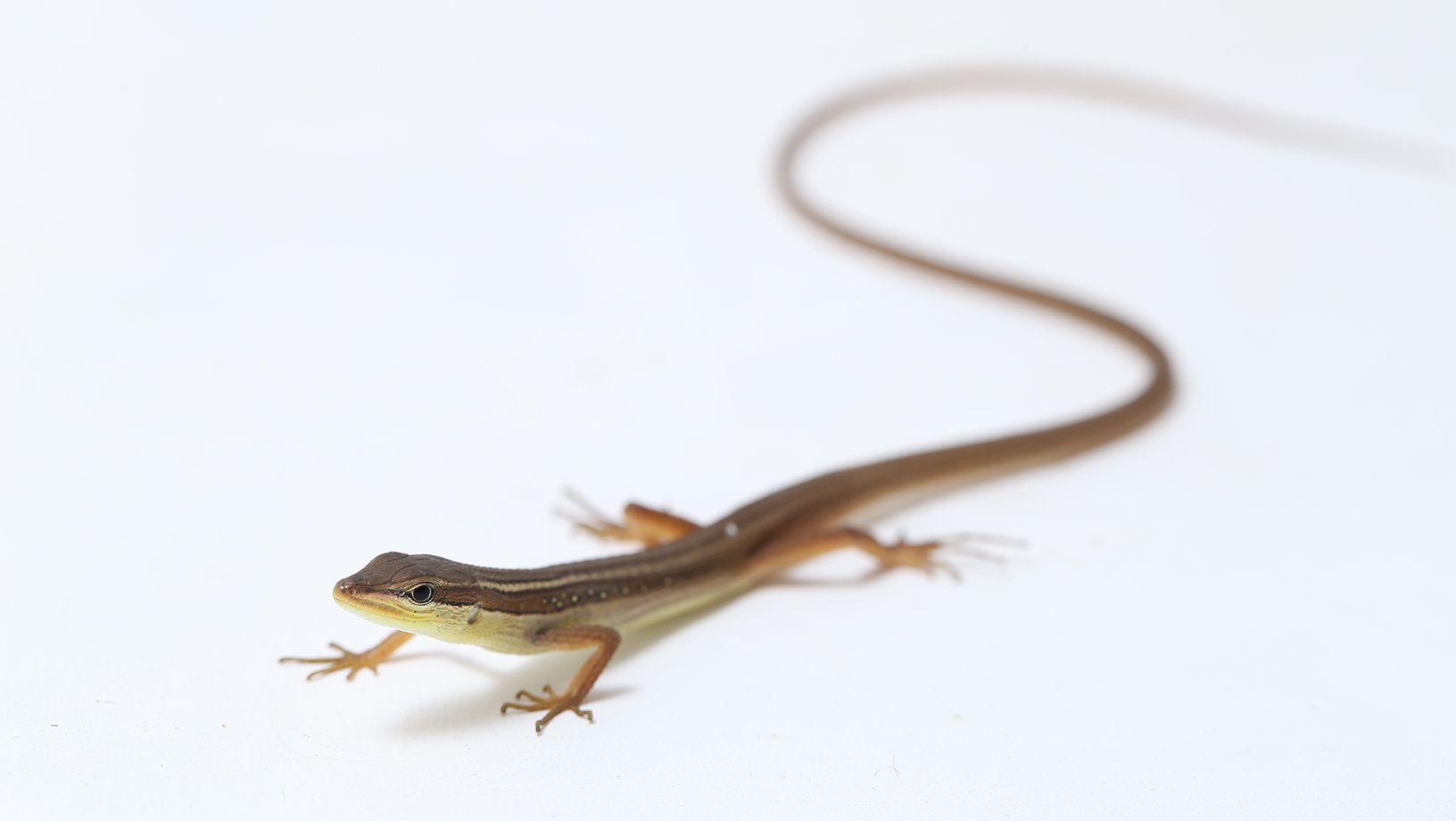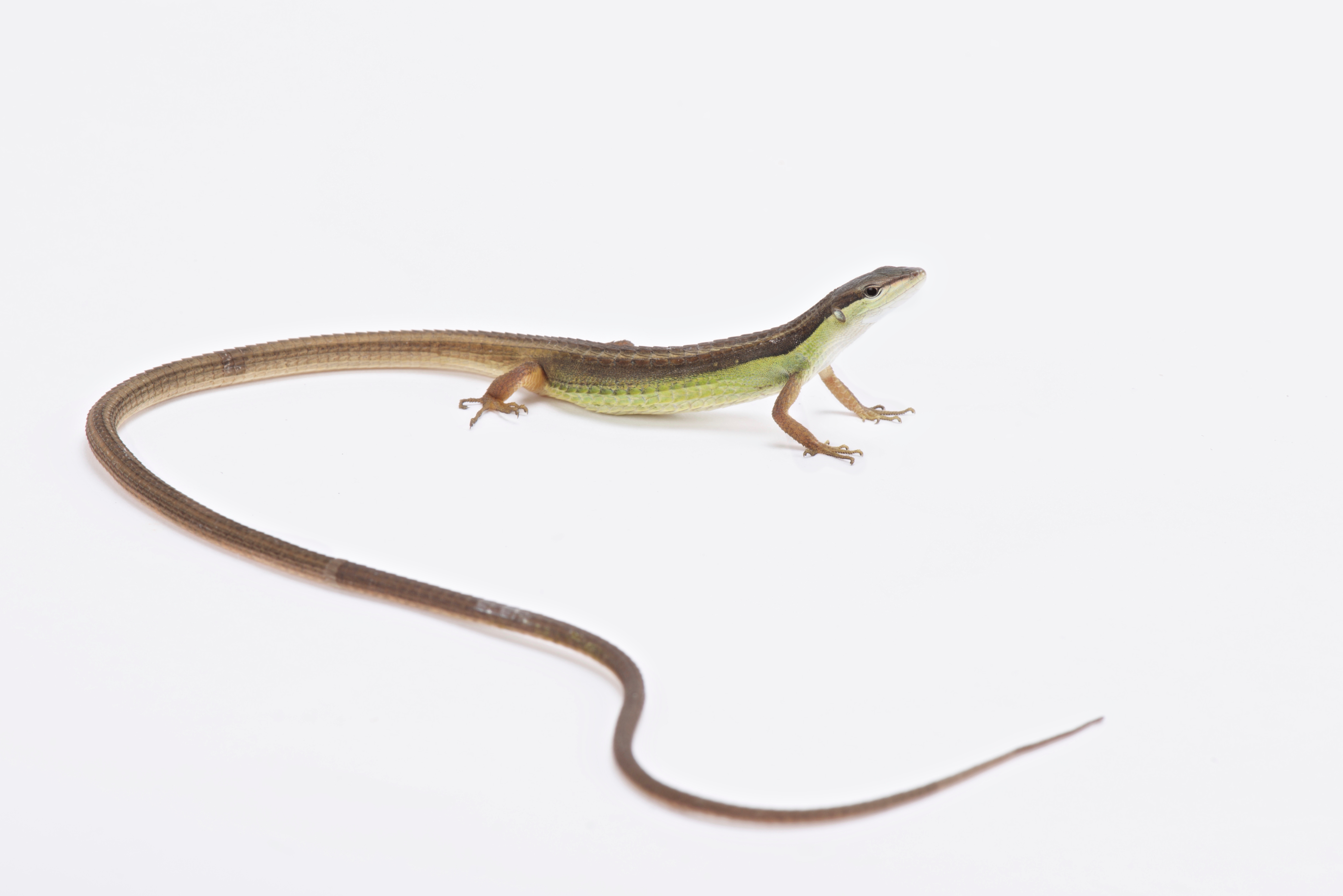Long-Tailed Lizard Care Guide

In this Article
Elegant and elongated long-tailed lizards!
The Long-tailed lizard, also known as the Asian grass lizard, is a very slender lizard that is native across Southeast Asia. These lizards get their name for abnormally long tails, often 3x longer than the rest of their body. In fact, Long-tailed lizards have the longest tail-to-body ratio of any reptile!
Long-tailed lizard species profile
Size: Long-tailed lizards grow up to 12" (30 cm) from nose to tip of their tail
Lifespan: They on average live 5 years
Behavior: Long-tailed lizards are diurnal meaning they are active during the day. They live in tropical areas, usually in tall grass.
Social behavior: They can be housed in groups, but it’s best to avoid housing multiple males together to prevent territorial disputes
Handling: These lizards startle easily and can be delicate. While they aren’t aggressive, they’re better suited as hands-off, display pets. With time and patience, some individuals may become comfortable being tong-fed or gently scooped up for brief interactions
Note on handling: If you do handle your long-tailed lizard, do not grab them by the tail. Always “scoop” them up from under the body and support the whole animal’s body and tail.
Setting up your long-tailed lizard habitat
Long-tailed lizards need a warm, well-ventilated environment with plenty of space to climb, explore, and hide. Their enclosure should mimic the dense, humid conditions of their native habitat.
Enclosure size and substrate
- Minimum size: A 20-gallon terrarium with a screened lid is the smallest acceptable option for a single adult
- Substrate: Use reptile-safe materials such as coconut fiber, bark blends, or moss. Reptile carpet or a solid mat also works well. Avoid sand, gravel, or loose soil that can pose ingestion or impaction risks
- Lighting: Set up your reptile lighting outside the terrarium, over top the screened lid, so your lizard has a warm area to bask in but cannot get so close to the bulb that they are burned.
- Many reptiles benefit from having access to UVB lighting. UVB allows the body to synthesize vitamin D3 which is critical for absorption of calcium. Some daylight bulbs will be rated to also provide UVB, and some won’t so it is important to check. Providing low-intensity UVB light over the basking site is recommended.
- Cleaning routine: Spot-clean daily, stir substrate weekly, and fully replace bedding and deep-clean the enclosure monthly
Climbing features and décor
- Include a variety of live or artificial plants, vines, and branches
- Provide multiple hiding spots using logs, cork rounds, or rock shelters
- Use both horizontal and vertical climbing options to mimic their natural environment
Temperature and humidity
Maintain a vertical temperature gradient, with a warm area near the top and a cooler zone below.
Zone | Temperature |
Cool side | 75 to 80°F (24 to 27°C) |
Warm side | 85 to 90°F (29 to 32°C) |
Basking site | 90 to 92°F (32 to 33°C) |
Nighttime | 65 to 75°F (18 to 24°C) |
Humidity range | 60 to 80 percent |
- For more information, consult PetSmart's "Reptile & Amphibian Heating & Lighting" and "Setting a Reptile or Amphibian Habitat" Care Guides
Care and feeding for long-tailed lizards

Long-tailed lizards are insectivores with fast metabolisms. Offer a varied diet of gut-loaded feeder insects to support energy, hydration, and long-term health.
Insects and feeding schedule
Feed once daily or every other day, depending on your lizard’s age and appetite.
Recommended feeders:
- Gut-loaded crickets
- Dubia roaches
- Black soldier fly larvae
- Mealworms (on occasion due to fat content)
Supplement routine:
- Calcium powder: 2 to 3 times per week
- Reptile multivitamin: Once per week
- Always follow veterinary guidance for supplement dosing
What does “gut-loaded” mean?
“Gut-loaded” insects are fed a high-quality, nutrient-rich diet before being offered to your pet. This ensures the feeder insect provides optimal nutrition. You can purchase pre-gut-loaded insects or gut load them at home using commercial insect diets or fresh vegetables.
Hydration
Your lizard will drink from standing water and absorb moisture from a humid environment.
- Offer a shallow dish of clean, dechlorinated water at all times
- Replace water daily
- Mist the enclosure regularly to support hydration and skin health
Feeding precautions
Never feed wild-caught insects. They may carry parasites or pesticide residues that can make your pet sick.
When to see a vet
In addition to regularly scheduled appointments, contact your reptile veterinarian if you notice the following signs:
- hiding more than usual
- eating or drinking less; weight loss
- swollen joints or reluctance to move
- discharge from the eyes, nose or mouth
- shedding problems; discolored skin
- runny droppings for more than two days
- decreased frequency in droppings
- increased basking time
Go to “find a vet” on arav.org for help finding a reptile veterinarian in your area.
NOTE: Most, if not all, reptiles carry Salmonella bacteria in their intestinal tract and intermittently or continuously shed these bacteria in their feces, so they are unsuitable pets for very young children and those with compromised immune systems. Good hygiene must always be practiced around all reptiles, and hands should be washed before and after interacting with reptiles.
SHOPPING CHECKLIST
- 20-gallon terrarium or larger
- secured screened lid
- combination of coconut fiber, reptile bark and moss substrate
- UVB bulb and fixture
- daytime basking bulb and lamp
- spray bottle or automatic misting system
- habitat thermometers (2) and a hygrometer
- artificial/natural rock or wood hide house
- branches for climbing and hiding
- water bowl
- crickets, black soldier fly larvae, dubia roaches, mealworms and waxworms
- calcium powder
- multivitamin powder
Ready to learn more? This guide is a great starting place, but we encourage you to do more research on the individual species that you are keeping so that you can be as successful as possible!
Related guides:
FAQs
Can long-tailed lizards live together?
Yes, but only with caution. Long-tailed lizards are generally social and can be housed in small groups, but males may become territorial. Avoid housing more than one male per enclosure to reduce fighting.
Yes, but only with caution. Long-tailed lizards are generally social and can be housed in small groups, but males may become territorial. Avoid housing more than one male per enclosure to reduce fighting.
How often should I clean the enclosure?
Spot-clean daily and stir the bedding weekly to prevent odor and bacteria buildup. Deep-clean the enclosure and replace all bedding every month.
Spot-clean daily and stir the bedding weekly to prevent odor and bacteria buildup. Deep-clean the enclosure and replace all bedding every month.
Do long-tailed lizards need UVB light?
Yes. While not as UVB-dependent as some reptiles, long-tailed lizards benefit from low-intensity UVB exposure to synthesize vitamin D3 and support healthy calcium absorption.
Yes. While not as UVB-dependent as some reptiles, long-tailed lizards benefit from low-intensity UVB exposure to synthesize vitamin D3 and support healthy calcium absorption.
Can I handle my long-tailed lizard?
These lizards are delicate and easily startled, so frequent handling is not recommended. With patience, some individuals may tolerate gentle interaction or hand-feeding. Always support the full body and tail, and never grab them by the tail.
These lizards are delicate and easily startled, so frequent handling is not recommended. With patience, some individuals may tolerate gentle interaction or hand-feeding. Always support the full body and tail, and never grab them by the tail.
What should I do if my lizard stops eating?
First, check habitat conditions—temperature, humidity, and cleanliness. Stress, incorrect temperatures, or poor lighting can all cause appetite loss. If your lizard refuses food for more than a few days, consult a reptile veterinarian.
First, check habitat conditions—temperature, humidity, and cleanliness. Stress, incorrect temperatures, or poor lighting can all cause appetite loss. If your lizard refuses food for more than a few days, consult a reptile veterinarian.

